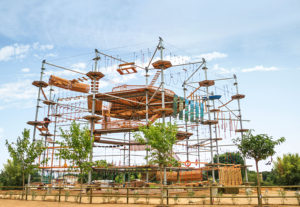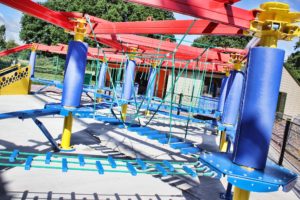FEATURE: Take it outside
…or inside. Adventure play and outdoor play are growing fast. Is it something you should be considering?
Parents are realising something important, and it’s something that is affecting leisure venues worldwide – that kids can’t spend all their time in front of a computer, tablet or TV. Families are spending more time together inside and outside the house; the Daily Mail reported in 2013 that families were spending just 36 minutes of ‘quality time’ together each day, with more like two hours 20 minutes at the weekend; a more recent survey in 2015 suggests that families are spending over two hours and 23 minutes together every day. Family activities are a growth area, and any leisure venue that caters for the whole family will tell you this. The consistent growth in redemption also points to this, with families seeking entertainment as a group at FECs and similar.
Leisure venues have a raft of options when it comes to adventure play, the sky really is the limit both indoor and outdoor. No outdoor space, or in an area where the weather is generally terrible? Look at a climbing wall or the many variants. Blessed with a good amount of sunshine every year on average? Why not look at high ropes courses, or some other exciting outdoor installation. There are even versions for the wee ones, so there’s no excuse there.
It’s not as simple as just deciding to stick something in and hoping for the best, though. David Yearley, Head of Play Safety, for the Royal Society for the Prevention of Accidents, told Global Amusements & Play magazine: “What one has to do is ensure the people using the facility are reasonably safe. The way that is enacted in law in the UK, there are two sides to it – the criminal side and the civil side of the law. The criminal side of the law covers you if you’re an employer. As an employer you have a legal requirement under the Health and Safety at Work Act 1974 to make sure you look after people affected by your undertaking. In other words, whatever you do as an employer you have to look after anyone affected by it – so that’s not just employees, it’s visitors as well. Further to that, out of the Act come various regulations – one of which is the Management of Health and Safety at Work Regulations 1999, that requires employers to conduct a suitable and sufficient risk assessment.
“That’s about it as far as the law requires; play and playgrounds have never come under any particular statute. They don’t cause huge problems generally so they have always fallen under that Act and people undertake the required risk assessments.
“If an employer has a balcony from which you could fall from height, that could be identified as a hazard, and control measure might be to put up a barrier to stop you falling off. When it comes to play you will want to install something exciting and challenging, so you might put something in that involves height and you can identify that people might fall off and hurt themselves – so your control measure might be barriers, or if there is a rope ladder they might not fall from the ladder, they might be more at risk at the platform at the top, so you might barrier there.
“That general principle is going to apply across a playground, except a judgement has to be made to ignore the trivial. You need knowledge of how children or users are going to use that space in order to work out the risks and decide responsibly what is trivial and what is not.
“What’s really important with play and where it differs from an occupational work setting, is that play, risk and challenge brings benefits, and so it is important that the control measures don’t swamp the benefits. Again, it’s a judgement that has to be made that if the benefit outweighs the risk, great; if the risk outweighs the benefit, something needs adjusting.”
 KristallTurm has been working in adventure play since 2010, with its space-saving hexagonally-structured KristallTurm high rope course inspired by the shape of ice crystals. The company has seen first-hand growth in the sector; Sara Kern told us: “Even though Europe was our first market and is still a stable and important market for us, the US market is growing rapidly.
KristallTurm has been working in adventure play since 2010, with its space-saving hexagonally-structured KristallTurm high rope course inspired by the shape of ice crystals. The company has seen first-hand growth in the sector; Sara Kern told us: “Even though Europe was our first market and is still a stable and important market for us, the US market is growing rapidly.
“But we have had projects also in markets you don’t expect, for example Cuba or Nigeria. Currently we are working on projects in Japan and Israel.”
What’s interesting is that the growth is coming partly from areas that want to expand their appeal to year-round. “The demand for free time activities that are exciting, sporty and for every age is steadily growing. For example ski areas: They are looking for summer activities because the winters are getting shorter and there will be less snow. A high ropes course is a good facility for them to reach their guests even in the summer.”
Have they spotted any trends in the sector, given their global customer base? Yes, it seems so. Sara added: “Our customer range is very broad and reaches from hotels to theme parks, sports facilities and wildlife parks or even individual entrepreneurs. We also notice that indoor high ropes courses are becoming more popular, especially in the UAE. Indoor projects are often customized, but also offer good ROI to the investor, since the facility can be operated independently from weather conditions.
Sara concluded that where you are is really rather important for your success: “Location is the key to successful operations in any attraction business. We offer our potential clients to analyze the location in terms of potential clients, competitors and so on. The other important factor is to operate the business professionally, with the highest standards in marketing, safety and guest relations. We also help our clients to install standards at their site, for example by offering staff training and support in creating a marketing plan.”
Lori Gunthorp, Marketing Manager for Skytrail in the U.S., says that the company is seeing great variety in its customer base going forward. She said: “34% of our inquiries received so far in 2017 have been for outdoor facilities ranging in industries from adventure and sports facilities, amusement parks, public recreation parks and water parks.”
 Iplayco’s Scott Forbes agrees that location is important, but adds that other aspects of an operator’s approach can be equally important. He told us: “Location will always be important but focus relating to location should always lean towards access which would include parking and proximity to other known public areas. Once the correct location is found, the next big hurdle is to build a facility that is in line with your business plan and correctly market it which is where a company such as ours comes in. The final and probably the most significant thing is to create and deliver customer satisfaction, to make it a daily goal in your facility.”
Iplayco’s Scott Forbes agrees that location is important, but adds that other aspects of an operator’s approach can be equally important. He told us: “Location will always be important but focus relating to location should always lean towards access which would include parking and proximity to other known public areas. Once the correct location is found, the next big hurdle is to build a facility that is in line with your business plan and correctly market it which is where a company such as ours comes in. The final and probably the most significant thing is to create and deliver customer satisfaction, to make it a daily goal in your facility.”
Iplayco has also seen growth in their business; they design and build FECs, from smaller children’s facilities to larger resorts and theme park-style venues, and also manufacture and install the play equipment for the facilities. Scott said: “we have seen increasing interest, specifically adventure play of any type (indoor or outdoor). People of all ages are always looking for some type of new interactive activities that challenge them physically and mentally. A good example of this trend is the interest in Air Trek and Rope Courses which are elevated activities that translate both into outdoor and indoor use. Recently we have started to see an increase in augmented reality features in a number of entertainment venues. We believe this trend to be another step towards totally immersive technologies that can be integrated into available activities at these venues.
“We have seen a growth in planning requests for larger scale facilities. These clients are looking for a variety of elements to be included not just one specific activity. These may include activities like Airtrek, Redemption Games, Climbing Walls, Laser Tag, Large Soft Contained Play Structures, Bowling, Rides etc. These clients also request varying degrees of Thematic customization as well that will include their specific branding.”
Tiphaine Lazard, Clip ‘n Climb International Marketing Co-Ordinator, is enthused by the company’s growing order book; she told Global Amusements & Play: “For sure it’s a growth area, we have increased our number of centres by 66% this past year and we have now more than 125 facilities with Clip ‘n Climb products in. We can easily say that we are the creators (the first Clip ‘n Climb has now 11 years old) and market leaders in the fun climbing market.
“The growth is driven by the diversity of leisure activities and the need for Family Entertainment Centres to stand out thanks to a different kind of fun. The huge trampoline craziness is also helping us to increase our development as these two activities match perfectly.
“We are now investing in digital innovations to bring additional services to our centres, with two new products which will be launched this year. As we are leaders, we are the company who drives the orientation of the fun climbing industry and all its aspects, as business plans, centre management, different ranges of products… Digital innovation is now the turn that we are taking and that the industry needs to take to keep increasing visitor interest.”
Innovative Leisure
Founded by Managing Director Phil Pickersgill in 2000, Innovative Leisure was born from his experience in the leisure industry in Europe and the desire to develop a new niche in the market. The initial objective for the company was to introduce unique family-focused adventure products, which started with climbing walls.
Today, Innovative Leisure’s portfolio consists of hundreds of successful installations and an ever-evolving product range, with constant research and evaluation of new ideas in order to introduce the most innovative attractions.
The addition of the Sky Trail range of high ropes courses, and the partnership with U.S.-based manufacturer Ropes Courses Inc. since 2010, has fueled significant growth for the company and team.
The company supplies attractions to fit many sectors of the leisure industry, including theme parks, visitor attractions, zoos, safari parks, activity and outdoor centres, holiday parks, farm parks, indoor play centres, scout groups, local authorities, emergency services, the Army, RAF and The Royal Marines, schools, colleges and independent operators.
